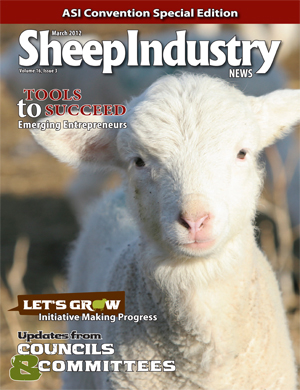
- March 2012
- Convention Continues Work to “Grow Our Flock”
- Avalos: Ag Bright Spot in U.S. Economy
- New ASI Executive Board Members
- ASI Recognizes Award Recipients at Convention
- “Expect the Unexpected”
- Powell Recognized for 50 Years of Service
- Re-Build Committee Makes Progress Over Past Year
- Emerging Entrepreneurs Meeting Opens Eyes
- Adjusting to New Norm in the Lamb Market
- 20 Years of Service
Adjusting to New Norm in the Lamb Market
By Amy Trinidad
Sheep Industry News Editor
(March 1, 2012) The headliner of the joint Lamb Council/American Lamb Board meeting at the American Sheep Industry Association convention was that the current lamb market softening is due to the market adjusting to a new norm, according to Erica Rosa-Sanko, agricultural economist at the Livestock Market Information Center.
“We are experiencing seasonality with the market right now,” said Rosa-Sanko, “but we are still going to witness record lamb prices in 2012 as it is a supply driven market.”
According to Rosa-Sanko, packers are chasing lambs therefore asked producers, “Can you do more with less?” She further explained that lambing percentages are an issue and that by increasing ewe efficiencies, it can help add value to your operation.
In terms of lamb competing with other proteins, Rosa-Sanko suggested looking at how the different cuts compare to cuts of other proteins.
“You have to think of it in terms of retail demand,” she said, explaining that the rack competes with the beef t-bone, the lamb shoulder competes with pork chops and that the neck and breast got more play against hamburger due to the burger craze.
“Think cuts competing, not general lamb.”
The variable in this year’s lamb market is going to be feed, according to Rosa-Sanko. She expects hay production to be the lowest since 1988 and corn will remain above $5 per bushel.
Although the industry did experience a 2-percent decline in total sheep and lamb inventory over the past year, Rosa-Sanko explained she does expect to see year-to-year increases starting next year as there are flock expansion efforts taking place.
For more coverage from Rosa-Sanko’s presentation at convention, please see the Market Report on page 6 of this issue.
Instrument Lamb Grading
For the past five years, the lamb industry has been working to establish performance standards for instrument prediction of lamb carcass factors and grades. A year-long study began in September 2009 at Superior Lamb in Denver, Colo., and the results presented to ASI’s Lamb Council at last year’s convention found the instruments performed at high levels regarding repeatability and accuracy in grading carcasses. The objective of utilizing these instruments is to reduce grade variations between plants and areas and increase accuracy, precision and resolution of grade factor assessments.
“We made excellent progress last year,” stated Lawrence Yates, Ph.D., from the U.S. Department of Agriculture’s (USDA) Agricultural Marketing Service, about determining the accuracy of carcass cutability yield and quality grade.
The goal of the carcass cutability yield was plus or minus 2 percent yield units, the equipment that was tested performed at an average residual of 0.09 percent. And with regards to quality grade, the average residual goal was plus or minus 10 quality grade units, the equipment performed at a 1.83 average residual.
The next step in the process is to get approval from USDA on the proposed standards and use of this system. Once approved under these standards, instrument grading systems may be used to assess the yield and quality grades in the official USDA grading process in accordance with USDA published procedures for the operation and maintenance of the technology.
In addition, a 30-day hot camera grading pilot project is scheduled for late spring or early summer in which the grading process will be moved to the processing floor.
According to Yates, there will be a USDA assessment and alignment of grade lines to ensure a transparent transition.
Lean on Lamb
As has been done over the previous years, a progress report from Allison Beadle of Fleishman-Hillard Inc. was given about the Lean on Lamb program.
The goal of the 2011-2012 campaign was to increase awareness and familiarity with lamb as a healthy protein by driving trial, word-of-mouth and media coverage.
The development of “The Supper Club with Lamb” was a major force within this theme. In addition to developing recipes and photography to convey health, flavor and ease of cooking; a booklet to tell the supper club story; and placing online ads to drive traffic to the Lean on Lamb website; a supper club kit – which included a cut of lamb, recipes and nutritional information about the protein – was developed for consumers and distributed to popular food bloggers in the key lamb markets of Boston, Washington, D.C., and Los Angeles to host a dinner party. A total of 25 supper clubs were hosted with 150 participants.
According to Beadle, the response from the bloggers was tremendous in that they talked about lamb’s nutritional value, posted pictures of the dish they created and blogged about the ease and versatility of the meat.
The supper club campaign continued with media outreach in outlets such as Martha Stewart Living, Food & Wine, Taste of Home and EveryDay with Rachael Ray. Beadle predicts they will soon be realizing the results from these efforts due to print and production schedules.
As for 2012, the Lean on Lamb campaign will continue to focus on growing the supper club series and continue to pull the nutritional messages of the past year.
She would also like to build-out the supper club section of the Lean on Lamb website, www.leanon lamb.com, to include a blogger photo gallery, continue online advertising and outreach to online media.

